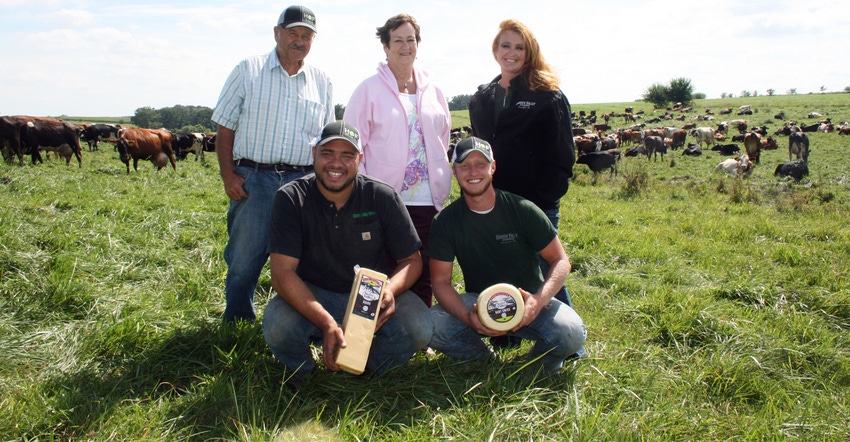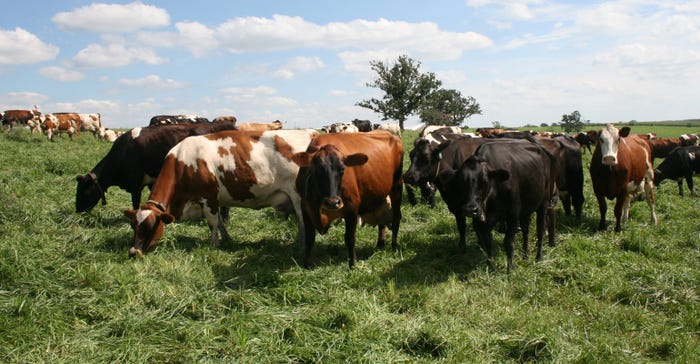January 12, 2017

The Opitz family uses innovative management practices and tools to successfully operate their large-scale grass-based dairy, Hidden Valley Farms, near Belmont.
Jen Opitz, along with her parents, Charlie and Dorothy Opitz, and sons, Lane Friedrich and Christian Galloway, work together to manage 1,150 dairy cows, plus 2,200 owned and 800 rented acres used primarily as pasture. Milk from Hidden Valley Farms is used to make several varieties of specialty grass-fed cheeses.
Pasture-based diet
“During the drought in the 1980s, we started grazing our milk cows out of necessity,” Opitz says. “Since that time, we’ve become a grass-based dairy, with the vast majority of our acreage being devoted entirely to pasture.”
Growing abundant high-quality forage in a pasture-based system takes a considerable amount of time, planning and effort. The grazing season typically starts at the beginning of April, once grass begins to grow, and ends around Thanksgiving. Pastures are on a 21- to 30-day rotation plan, depending on growing conditions.
Cows only graze a pasture for one or, at the most, two milkings before being rotated. Sometimes, groups of heifers are used to follow up cows in pastures with ample vegetation leftover. Each day throughout the summer, an employee runs a tractor and mower in pastures to clear undesirable plants and make room for fresh, new growth. Forages are also harvested and stored to be fed over winter months.

GRAZING COWS: Hidden Valley Farms includes a large, grass-based dairy with 1,150 crossbred cows. (Photo courtesy of Swiss Valley Farms)

Over time, the Opitz family has perfected their genetics program as they strive to breed for productive, trouble-free cows that thrive in a grazing environment.
“After we started grazing, we began experimenting with crossbreeding,” Opitz explains. “We breed with Ayrshire, Friesian Holstein, Jersey, Montbeliarde and Swedish Red. Anything that will be efficient on grass will do well in our system.”
Calving is split into two seasons on the farm. From the end of March through June 1 is the first wave. From the beginning of August through Nov. 1 is the second round. Sometimes up to 300 cows are due within a condensed period of time. Calves are housed in individual calf hutches or in group housing.
“From my experience, there are health benefits for the cows in pasture-based dairying,” Opitz says. “Once a new calf is born here, it typically doesn’t see the inside of a building until it enters the milking parlor after it freshens. Along with many other factors, it creates a healthier environment for the cows. We see less respiratory issues and structural issues with feet and legs on the cows.”
Activity-monitoring systems are used to collect and analyze data on individual cows in the herd. They are an effective tool for heat detection as well as health and nutrition information. Conventional heat-detection systems weren’t designed to be used in a grazing environment due to the high amount of movement by cows. Working with a company that markets heat-detection systems, Hidden Valley Farms has one of the first sets of activity monitors used on grazing cows.
“Having an activity-monitoring system in place makes life easier,” says Opitz. “Now that we’ve developed collars for pasture-based systems, we can tell if a cow is sick or in heat before you’d regularly notice it.
“Every farm is different,” Opitz says. “What works for us might not work for everyone else. We like to keep our cows happy. If our cows are happy, everything else will fall into place.”
Giebel lives in Baraboo.
About the Author(s)
You May Also Like




